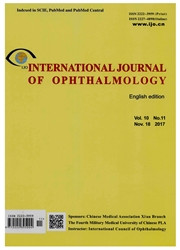

 中文摘要:
中文摘要:
· AIM: To quantify the changes in the lens profile with accommodation in different age groups. · METHODS: The Pentacam HR system was used to obtain the images of the anterior eye segment from 23 young and 15 presbyopic emmetropic subjects in unaccommodated (with an accommodation stimulus of 0.0D) and accommodated (with an accommodation stimulus of 5.0D for the young group and 1.0D for the presbyopic group) states. The phakic crystalline lens shape, including curvature of crystalline lens and central lens thickness (CLT), and the measurements of anterior segment length (ASL), central anterior chamber depth (CACD) were investigated. The anterior chamber volume (ACV) was also measured. · RESULTS: The reduction of CACD and ACV were significant in both groups after accommodation stimulus. From the profile of anterior eye segment, a significant decrease in anterior crystalline lens radii of curvature (-2.52mm) and a mean increase in CLT (0.222mm) and ASL (0.108mm) were found in the young group with an accommodation stimulus of 5.0D. However, no statistically significant changes of CLT, ASL, or crystalline lens radii of curvature were found in the presbyopic group. · CONCLUSION: Our data showed that the shallowing of anterior chamber during accommodation was caused by the forward bulging of the anterior lens surface, rather than by anterior shifting of lens position in either young or presbyopic subjects. ·
 英文摘要:
英文摘要:
AIM: To quantify the changes in the lens profile with accommodation in different age groups. METHODS: The Pentacam HR system was used to obtain the images of the anterior eye segment from 23 young and 15 presbyopic emmetropic subjects in unaccommodated (with an accommodation stimulus of 0.0D) and accommodated (with an accommodation stimulus of 5.0D for the young group and 1.0D for the presbyopic group) states. The phakic crystalline lens shape, including curvature of crystalline lens and central lens thickness (CLT), and the measurements of anterior segment length (ASL), central anterior chamber depth (CACD) were investigated. The anterior chamber volume (ACV) was also measured. RESULTS: The reduction of CACD and ACV were significant in both groups after accommodation stimulus. From the profile of anterior eye segment, a significant decrease in anterior crystalline lens radii of curvature (-2.52mm) and a mean increase in CLT (0.222mm) and ASL (0.1138mm) were found in the. young group with an accommodation stimulus of 5.0D. However, no statistically significant changes of CLT, ASL, or crystalline lens radii of curvature were found in the presbyopic group. CONCLUSION: Our data showed that the shallowing of anterior chamber during accommodation was caused by the forward bulging of the anterior lens surface, rather than by anterior shifting of lens position in either young or presbyopic subjects.
 同期刊论文项目
同期刊论文项目
 同项目期刊论文
同项目期刊论文
 期刊信息
期刊信息
